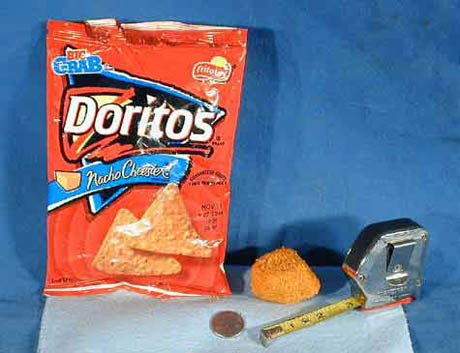
IMAGE: A nugget of pure Doritos flavour dust unearthed from the bottom of a lucky bag and subsequently put up for auction on eBay.
Do you have a considered opinion on how small a crisp or tortilla chip fragment has to be before it is not worth eating, or are you the kind of person who uses a moistened finger to retrieve the flavour dust from the foil corners of a bag?
Does the concept of a KFC Double Down — a sandwich that is “so meaty, there’s no room for a bun” — trigger guilty speculation as to the desirability of using meatloaf slices around your next PBJ or melancholy reflections on the demonisation and decline of bread?
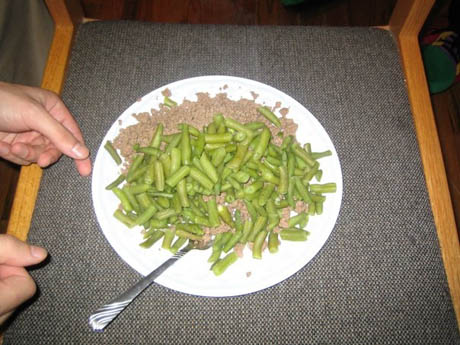
IMAGE: A pound of ground beef and a can of green beans, cooked and consumed in pile format by Sebastian Podesta.
Have you ever cooked and eaten something that could only be described as a pile, in which half a pound of leftover pasta, stir fried with canned tuna and sliced beets, is topped with a layer of Kraft Singles, ketchup, mustard, mayo, and Sriracha (or similar)? Perhaps you have purchased and consumed — preferably alone and yet unashamedly — a spicy pickled sausage called the “Tijuana Mama.”
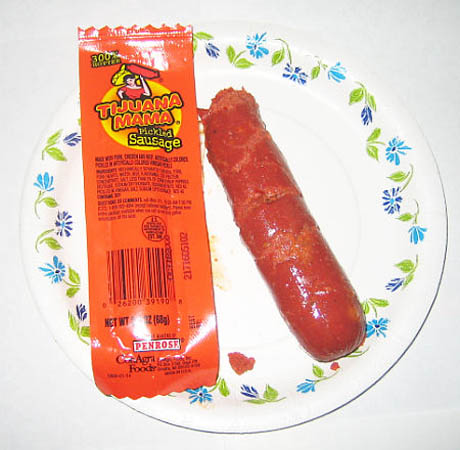
IMAGE: The original Dark Sausage: “about as junky as junk food can get,” according to the Junk Food Blog.
If any of the above apply to you, or even just pique your interest, then congratulations are in order: you are a Dark Arts practioner or philosopher — or both.
According to artist Jeff Sisson, who will be familiar to faithful Edible Geography readers as the creator of “The Bodega List,” the term Dark Arts refers to “an emergent set of gross food practices.” On a spectrum of edible disgustingness that ranges from guilty pleasures to pink slime, the Dark Arts can be loosely defined as mainstream yet mysteriously overlooked absurdist food products, processes, or phenomena.
Sisson hosted the first Dark Arts Summit last year, in an effort to draw more attention to this neglected aspect of food culture through a series of discussions and demonstrations that surveyed current events and trends in the Dark Arts, and highlighted some of the latest research from Dark Arts practitioners. Speakers at this “gross TED” addressed topics as diverse as lime-infused beers, the history of goo-as-food, meat-as-bread, meta-sandwiches, food piles, New York City buffet aesthetics, and, of course, chip bag dust.
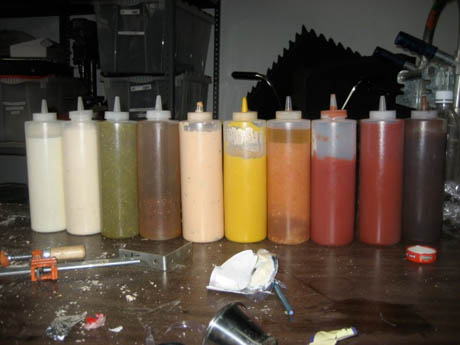
IMAGE: From “Party Tray Plus,” a goo machine of sauces created by the collective Double Happiness, cited by Bennett Williams in his talk on Goo at last year’s Dark Arts Summit.
Sisson has posted some of the (unedited) transcripts on his website, from which it becomes clear that much of the conversation centered around the question of when exactly a food practice or product crosses over into Dark Arts territory: sauces, for example, are a pillar of classical French cuisine, and yet the idea of sitting down to a platter of mixed sauces for dinner is gross. Meanwhile, a taste test confirmed that while Miller Chill is definitely Dark, a Corona served with a wedge of lime can perhaps only be considered historically, rather than actually, so.
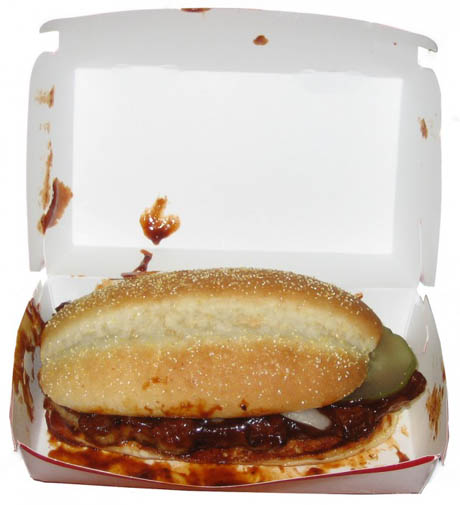
IMAGE: Pork offal slurry or financial instrument? Photo via The Awl.
All of which should serve, I hope, to whet your appetite (mentally, if not literally) for the Dark Arts Summit 2012, which is being held this coming Saturday, April 21, from 2 to 5pm, at Studio-X NYC. All are welcome (no charge for admission and no RSVP necessary) for a smorgasbord of grossness, including presentations on foods with proper names, the wings industry (by Willy Staley, proponent of the wonderful arbitrage theory of McRibs), combo restaurants, George Foreman formats, and Eastern Darkness in Western Queens, as well as a keynote lecture, live demonstrations, and a charette-style discussion. Sisson encourages attendees to bring something dark — either food or information — to share. I hope to see you there!
Dark Arts Summit 2012
Saturday, April 21, 2 — 5pm
Studio-X NYC, 180 Varick St. Suite 1610 (map)
For more information, contact Jeff Sisson through the email address on his website.
Discover more from Edible Geography
Subscribe to get the latest posts to your email.

This post came rushing back to mind today when I came across this recipe for ‘Mac and Cheese pancakes’. I think they’re trying to dress this doll up, but I’m still a little skeptical… and simultaneously craving them. http://www.randomhouse.com/knopf/ecards/shopsin/
Too bad it’s not taking place today… (4/20, at least in the US).
I’d like to see the Dark Arts and Stoner Arts venn diagram.
Darn. Can’t possibly be there. But then again, the only Dark Art in which I regularly indulge is The Pile. But not nearly often enough; I have to be alone.
Who doesn’t like chip bag dust?!